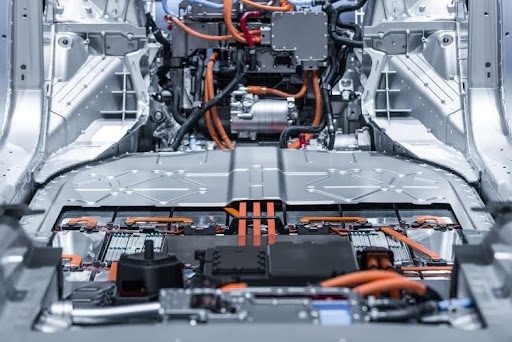Listen to this blog.
Electric vehicles (EVs) are no longer a trend; they’re here to stay! Every year, more and more people are making the switch to an EV. But there’s still a long road ahead before all passenger vehicels are fully electric. EV considerers may want a better understanding of what’s involved with owning an EV.
Let’s debunk myths and discuss practical tips. Buckle up and enjoy the EV ride with these tips and tricks to make the most out of your battery!

Understanding EV batteries.
Unlike conventional car batteries, which are primarily composed of lead-acid, EV batteries utilize lithium-ion (Li-ion) technology. These are bigger, considerably more powerful versions of the batteries powering your smartphone or laptop. Packed with energy, they outperform regular batteries — think of EV batteries as the energy-packed quinoa to your health-conscious meal plan, providing a long-lasting, efficient power source to your vehicle.
However, remember that certain factors can affect the efficiency and longevity of your EV battery, including high speeds, extreme temperatures, and heavy use of heating or air conditioning. By understanding these influences, you can improve your driving habits to bring out the best in your electric vehicle.
The lifespan of car batteries.
The life expectancy of EV batteries mostly depends on the specifics and usage of your particular battery and on maintaining responsible charging practices (don’t worry, we’ve got you covered — just keep reading!). Typically, it can be between 160,000 to 320,000 km (approximately 1,000 to 2,000 full charging cycles). Beyond this, while the batteries can still hold a charge, their capacity is usually reduced to around 80%.
Technological advancements have slowed down EV battery degradation. Newer Li-ion batteries are designed to withstand regular charging and recharging, making speed-diminishing battery health a thing of the past!
It’s also important to note that used EV batteries can have a second life. When they are no longer useful for cars, they still have a capacity for other uses that demand less from the battery. They can store energy generated by rooftop solar panels and provide electricity during blackouts or when solar energy is insufficient. This is a wonderful example of true sustainability!
What causes EV battery degradation?
Three key factors that can affect the lifespan of an EV battery include the following:
Frequency and method of charging.
Adopting regular and appropriate charging habits, you not only extend the battery life but also ensure optimal performance. It's not just about the frequency — the choice of charging methods matters too. Embracing diverse charging options, such as fast and trickle charging, empowers you to tailor your approach. Consider investing in a level 2 home charging solution, like Ivy Home, for overnight charging convenience and sustained battery efficiency.
Temperature and climate where the vehicle is being driven.
The temperature and climate greatly influence a vehicle’s performance and battery life. Extreme temperature fluctuations can cause strain on the battery and may require more frequent maintenance checks. Like a chocolate bar in the sun, your car battery isn’t a fan of extreme temperatures.
Overall usage pattern of the vehicle.
Understanding the overall usage pattern of a vehicle is vital to optimizing its performance and maintenance. Driving style, frequent short trips, and heavy accessory usage can affect the vehicle’s battery life and general wear and tear. Monitoring and keeping track of better driving habits can enhance your vehicle performance and extend service life. Think of it as journaling — but for your car.
Tips to extend your battery’s life.
Avoid daily charging.
Charging your EV battery every night isn’t always necessary. Newer EVs can manage daily commuting and errands, meaning the battery doesn’t always need to be topped up daily. Li-ion batteries work best when charged between 20%–80%. Keeping within this range can reduce battery stress and prolong its lifespan. On the contrary, frequently maintaining a 100% charge or discharging to 0% can degrade the battery faster. So, instead of charging daily, consider plugging in your EV just two or three times per week.
Store your car with the battery charge between 50-60%.
Battery degradation can occur if an EV is left parked for too long with a full or empty battery. According to Battery University, maintaining a battery at a high temperature and state of charge can cause more stress than using it too much. Rather than leaving the battery full or empty during storage, we suggest you store your car with the battery charge at around 50–60% to maintain its health. If possible, keep your car in a cool storage area to slow down the battery aging process.
Make sure to always consult your vehicle manufacturer’s recommendations as they all may have slightly differing recommendations.
What would an EV battery replacement cost?
Battery replacement might be a big worry when considering the cost of maintaining an EV. According to a report from ConsumerAffairs, the cost of replacing an EV battery ranges from $4,000 to $18,000.
Most new EVs have a battery warranty, ensuring coverage for kilometres driven over a certain period. They typically span 8 to 10 years or around 160,000 to 240,000 km. These warranties also vary based on the manufacturer, so we suggest owners get familiar with their vehicle’s warranty terms.
Make the most of your battery life: Give them a second or even a third chance.
The life of your EV batteries doesn’t need to be over after they’re no longer useful for your car. After that, they often retain considerable capacity (about 70–80%) making them valuable for other uses. But how? We recommend giving them a second chance in energy management systems, storing excess power during low electricity demand and supplying it during peak hours.
Batteries hold an incredible potential beyond their initial use in electric vehicles thanks to remarkable innovations in recycling methods. We can effectively give these materials multiple lives by recovering precious materials like lithium, cobalt, and nickel. This approach conserves resources and minimizes the environmental impact, contributing to sustainable and economic progress to a cleaner future.
Have you ever watched a movie where the hero gets a second shot at making things right? That’s your EV battery in its second life — it may not power your car anymore, but it turns into a superhero, storing backup energy for your home or business!

Driving change: Paving the way to an electrifying and sustainable future.
Embracing the electric revolution is all about understanding the nuances of EV technology, battery maintenance, and charging solutions. With an informed perspective on battery life, degradation factors, and the overarching benefits of EVs, we’re well on our way to a more sustainable future.
By choosing EVs, consumers contribute to a more sustainable future, paving the way toward a less polluted environment. Let’s start making a conscious effort for a better future today!
Join our electric community.
Be the first to hear about Ivy tips, promotions, and network updates.